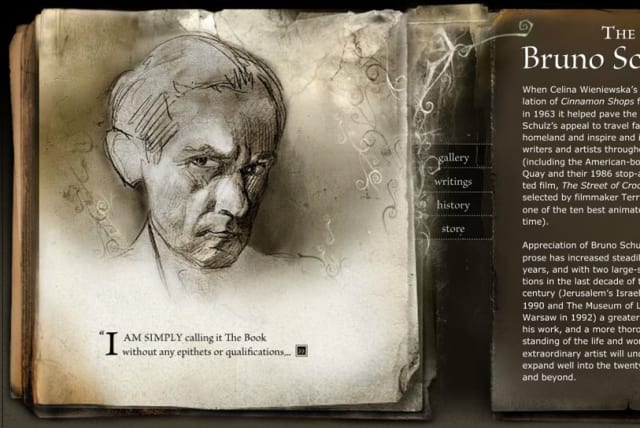'Bruno Schulz': Israel and Poland's battle over Holocaust victim's art - review

Benjamin Balint returns with another book presenting the conflicting claims and arguments of another case of Israel attempting to safeguard the cultural treasures of Holocaust victims.
On May 19, 2001, three Israelis – Yad Vashem archivist Mark Shraberman; Yosef Shenhav, director of the restoration laboratories of the Israel Museum; and Eliyahu (Ilya) Matskin – went to an apartment building in the Ukrainian city of Drohobych, which had been the residence of the S.S. Hauptsharfuhrer Felix Landau, a notorious sadist, who participated in the mass murders carried out by the Einsatzgruppen throughout Eastern Galicia, and was responsible for the fate of the city’s Jews.
The Israeli team were operating on orders of Yad Vashem chairman Avner Shalev, who sent them to remove several murals painted by Polish Jewish artist and writer Bruno Schulz at Landau’s request, for his children. The Israelis took the most important murals drawn by Schulz on the walls, leaving several others, which were removed a year later by Ukrainian conservators and restored, and are currently displayed in the Drohobych Museum.
The removal by the Israelis of the paintings sparked a huge scandal, and accusations of collusion by local officials, bribes by the Israelis, and violations of Ukrainian, Polish, and international law. Ironically, the theft of the murals aroused far more attention, than Schulz’s literary and artistic work had ever received, either in his city and country of residence, Drohobych, Ukraine, where he was murdered by the Nazis, or in Poland, his country of citizenship and in whose language he wrote.
Benjamin Balint’s previous book, Kafka’s Last Trial; The Case of a Literary Legacy won the Sammy Rohr prize for Jewish literature, was a brilliant account of the legal struggle over the ownership of Franz Kafka’s archive between the Israel National Library and the family of the secretary of Max Brod, Kafka’s closest friend and confidante. Balint did a masterful job of presenting the conflicting claims and arguments of both sides, several of which had far-reaching ramifications concerning the State of Israel’s role in safeguarding the cultural treasures of decimated European Jewry, and of those families victimized during the Holocaust.
Who has the rights to Bruno Schulz's art?
He was thus eminently capable of presenting the various sides of the intense and fascinating debate over where Bruno Schulz’s artistic and literary legacy should be preserved. In this case, the issue of Holocaust memory was preeminent, given the fact that Schulz was murdered in the Holocaust, and several of his works were influenced by his experiences during the Shoah. Balint notes the severe criticism of various Polish writers and media outlets, such as Gazeta Wyboreza which, for example, accused Israel of “stealing Schulz” or of Rzeczpospolita, which published a cartoon of a truck labeled “Yad Vashem Institute,” driven by bearded Jews with payot, carting away an entire Polish town on its trailer. Balint correctly points out that this issue was also affected by the controversy over the discovery that Poles, not Germans, had slaughtered the Jews of Jedwabne in 1941, which added considerable fuel to the fire of local antisemitism.
The counter-arguments are quite convincing, however, and Balint does Israel’s cause justice by citing additional cases of Jewish cultural treasures created outside Israel, which were brought to the Jewish state either to ensure their safety, such as the 10th-century Aleppo Codex, the most authoritative version of the Hebrew Bible, written in Syria brought to Jerusalem in 1957; or a collection of paintings by Marc Chagall, brought from Paris to the Israel Museum by Jerusalem mayor Teddy Kollek in April 1990.
My mentor, Prof. Yehuda Bauer, the doyen of Holocaust historians, sums up the argument for bringing Schulz’s works to Israel to be shown at Yad Vashem as follows:
“I do recognize the legitimacy of the Polish struggle for keeping the artwork of Schulz. But Schulz was murdered because he was a Jew, not because of his Polish citizenship. In the eyes of his Polish contemporaries, he was a Jew, not a Pole, whatever his own views may have been…. I think that as he was killed for his Jewishness, there is every justification for his work to be kept by Yad Vashem, an institution set up to commemorate Jews killed because they were Jews, whatever their formal citizenship.”
Benjamin Balint has produced a second book of unique importance regarding national memory and commemoration, and he presents the issues from all sides in a comprehensive and fair manner, which allows his readers to make their own decisions. I highly recommend both books. ■
Dr. Efraim Zuroff is director of Simon Wiesenthal Center-Israel office and Eastern European Affairs and coordinator, SWC Nazi war crimes research worldwide.
Bruno Schulz: An Artist, A Murder, And The Hijacking Of HistoryBenjamin BalintW.W, Norton, 2023320 pages, $30.00
Jerusalem Post Store
`; document.getElementById("linkPremium").innerHTML = cont; var divWithLink = document.getElementById("premium-link"); if (divWithLink !== null && divWithLink !== 'undefined') { divWithLink.style.border = "solid 1px #cb0f3e"; divWithLink.style.textAlign = "center"; divWithLink.style.marginBottom = "15px"; divWithLink.style.marginTop = "15px"; divWithLink.style.width = "100%"; divWithLink.style.backgroundColor = "#122952"; divWithLink.style.color = "#ffffff"; divWithLink.style.lineHeight = "1.5"; } } (function (v, i) { });

